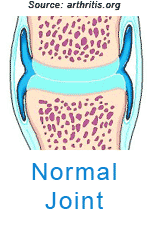Arthritis
Arthritis refers to pain, inflammation or disease of the joint, although some types of arthritis can also affect other organs such as the heart, eyes, lungs, kidneys and skin.
According to the Arthritis Foundation, there are over 100 different types of arthritis grouped into the following categories:
- Degenerative Arthritis – when the cartilage pads that line the joint surfaces wear out. Most common type: osteoarthritis.
- Inflammatory Arthritis – when the immune system attacks the joints and sometimes other organs, even the skin. Common types: rheumatoid arthritis and psoriatic arthritis.
- Infectious Arthritis – when a bacterium, virus or fungus enters and inflames a joint.
- Metabolic Arthritis (also known as gout or gouty arthritis) – high levels of uric acid that the kidneys don’t eliminate.

Osteoarthritis
Osteoarthritis (OA) is the most common form of arthritis. It is generally described as the degeneration of the cartilage pads that line the joint surfaces. Joint cartilage, called articular cartilage, covers the ends of bones and acts as a friction-free surface and a cushion. The cartilage does not have any nerve ends nor does it have a blood supply so when it is traumatized, you don’t feel much pain nor does it bleed. However, over time these cartilage pads crack and wear away exposing the bone underneath (subchondral bone). The bone thickens, bone spurs (technically called osteophytes) form, and inflammation of the joint occurs.
According to the Arthritis Foundation, 21 million Americans have osteoarthritis. It affects middle-aged people as well as seniors. Factors that increase your likelihood of experiencing an osteoarthritic joint are:
- Weight – the heavier you are the more likely you will experience OA.
- Trauma – joints that have experienced trauma are more likely to develop OA.
- Infection – if your joint was infected in the past, it is more likely to develop OA.
Symptoms include joint stiffness, pain, stiffness after prolonged sitting/lying, catching and grinding of the afflicted joint, redness, warmth, swelling, and difficulty using the involved joint.
It is important that you obtain the appropriate diagnosis from your medical doctor. Once diagnosed with OA, there are some things that you can do to slow its progression. Weight loss, strengthening, physical therapy joint mobilization, aquatic exercise, ice when inflamed, heat with stiffness, and bracing the joint can all help. Ask your rehabilitation specialist which is best for you.
A common question that patients ask is, “Does glucosamine help my arthritis?” More recent studies seem to indicate that glucosamine sulfate does have a positive effect on osteoarthritis. Glucosamine is one of the “ground substances” or important molecules that make up cartilage. Adding this over-the-counter supplement to your diet may have positive effects on mild to moderate osteoarthritis. Some research indicates that glucosamine can provide pain relief and may decrease the progression of the disease. Though not conclusively proven, it is also theorized that glucosamine may even reverse the progression of the disease.
The last resort is joint replacement.